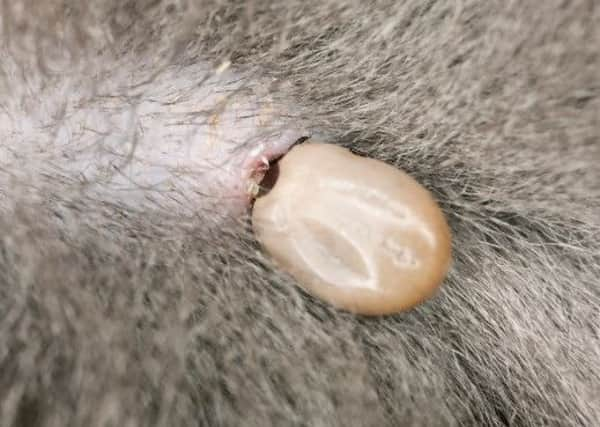Battle against ‘growing problem of tick bites on dogs’


Tick bites can transmit serious infections, such as Lyme disease, a serious and debilitating illness that can cause long term health problems in dogs and people.
In the UK, Public Health England estimates the number of new Lyme Disease cases each year at around 3,000 while Lyme Disease charities say the figure could even be as high as 15,000 annually. However, the majority of people are unaware that this potentially debilitating condition also affects our pet dogs.
Advertisement
Hide AdAdvertisement
Hide AdThe University of Bristol’s Big Tick Project is being supported by TV presenter, naturalist and dog lover Chris Packham, and aims to raise awareness of the risks and symptoms associated with tick-borne disease, and to educate owners how they can reduce their dog’s exposure to ticks and the diseases they carry.
Any ticks found on dogs will be collected and sent to Bristol University laboratories to help advance the knowledge of tick-borne disease, benefiting both veterinary and human medicine.
Chris Packham feels the challenge of keeping dogs and people tick-free has never been greater,
He said: “Research highlighted by the Big Tick Project experts at Bristol University suggests that ticks are a growing problem, especially in areas such as urban parkland, woodland or open country.
Advertisement
Hide AdAdvertisement
Hide Ad“While I find both ticks and fleas interesting creatures, I don’t want them on my dogs, in my house, or on me.
“I want the best advice and treatment available and I know I can get this by talking to my vet.”
Ticks are hard to spot when small but can transmit infections as they feed off the blood of their host. Dog owners often see ticks when they have increased in size as a result of their blood meal but by then the damage may have been done.
Tick facts:
A single female tick can lay several thousand eggs at a time.
Advertisement
Hide AdAdvertisement
Hide AdIt can take up to three years for the adult tick to develop.
Tick saliva contains an anaesthetic, so your dog will not feel the bite and neither will you!
Check your pet’s skin starting from its head then work your way down its forelegs and the rest of its body, searching for any lumps on the skin surface.
The place where the tick attaches may or may not be painful and there may be skin swelling.
If you find a tick on your dog’s skin:
Advertisement
Hide AdAdvertisement
Hide AdThe ideal device for tick removal is a specially designed hook with a narrow slot which needs to be slid with care under the tick at skin level so as to grip the head of the tick
Secure the hook in place around the head of the tick, ensuring that it is not entangled in hair. The hook is then rotated around its axis several times until the attachment is freed. The loose tick will then be easily detached and removed without putting either the tick or skin under tension
When attempting to remove a tick avoid handling the parasite directly without gloves - remember ticks carry unpleasant infections!
DO NOT attempt to burn, cut or pull the tick directly off - If you do so it is likely that parts of the tick head or mouthparts will be left behind.
Tips on keeping your dog tick-free
Advertisement
Hide AdAdvertisement
Hide AdGroom your pet regularly - checking for evidence of new tick infestations.
Discuss the risks posed from ticks and other common pet parasites with your practice and follow their recommended approach to ensure optimal control for your particular circumstances.
Follow your vet’s treatment recommendations fully and at the correct intervals for the product in question.
New advances and treatment innovation means that there are a number of ways that vets can control ticks, including the use of spot-ons (typically applied every four weeks), sprays, collars and oral chewable formulations which can last up to 12 weeks.
Advertisement
Hide AdAdvertisement
Hide AdThat means there should be an easy and practical solution for every owner who wants to help protect their dog against ticks.
Dog owners wanting to take part in the Big Tick Project with a tick check for their dog(s) or to find out more about the risks from tick bites can visit www.bigtickproject.co.uk or contact their local vets.
Don’t miss out on all the latest breaking news where you live.
Here are four ways you can be sure you’ll be amongst the first to know what’s going on.
1) Make our website your homepage
2) Like our Facebook page
3) Follow us on Twitter
Advertisement
Hide AdAdvertisement
Hide Ad4) Register with us by clicking on ‘sign in’ (top right corner). You can then receive our daily newsletter AND add your point of view to stories that you read here.
And do share with your family and friends - so they don’t miss out!
Always the first with your local news.
Be part of it.